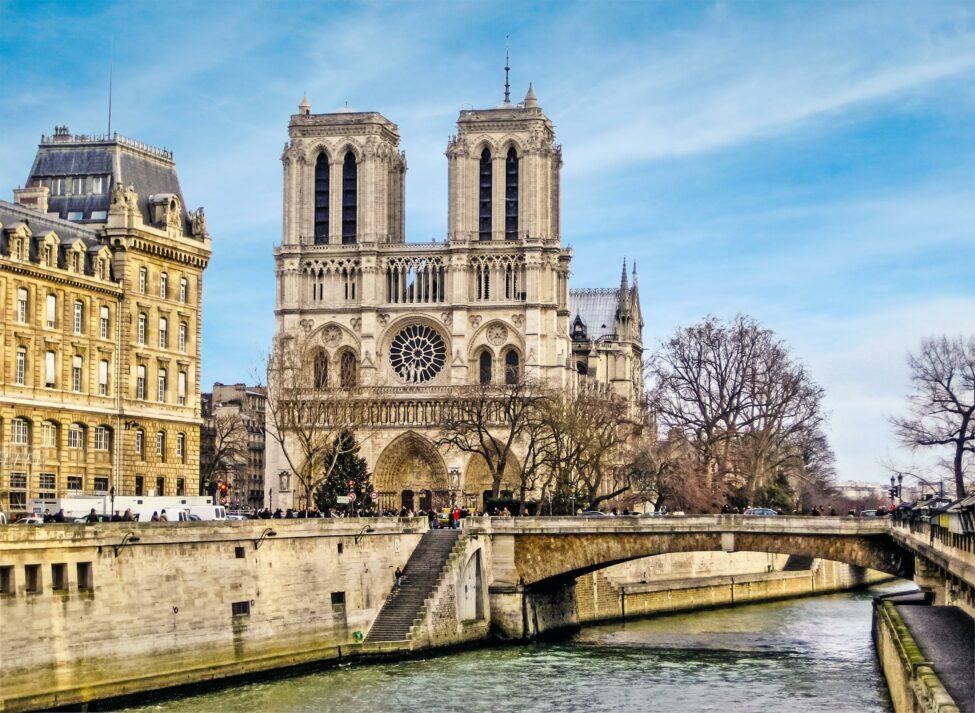After the fire at Notre Dame Cathedral, we're reflecting on this architectural masterpiece at the heart of Paris.
It feels odd to mourn a building, but Notre Dame is more than a building–it’s a symbol of one of the greatest cities in the world. For those of us who have been lucky enough to call Paris home (if only for a short while) and for those who have only visited in their dreams, Notre Dame is the heart of the city. It’s a monument that transcends religion and transcends nationality in order to honor art, culture, and history.
In 1163, the first stone of the edifice that would become Notre Dame was laid. Over the next several centuries, countless workers toiled to create the majesty of the cathedral: workers left their mark by signing a symbol–a heart, a square, a cross–on limestone blocks that became its foundations and walls. Woodworkers carved the stories of the Acts of the Apostles into wooden panels that lined the choir. Glassworkers painstakingly created each individual pane of colored glass to make up the three rose windows, on the west, east, and southern faces of the Gothic masterpiece.
Notre Dame doesn’t welcome 12 million visitors a year solely for Mass. Since 1905, the cathedral has been owned, not by the Catholic Church, but by the State, and it is as much a French symbol as it is a religious one. Just outside, a Point Zero marker indicates the place from which distances to Paris are measured. It’s the geographic heart of Paris.
Recommended Fodor’s Video
The cathedral bore witness to the 1789 French Revolution, when secularists temporarily rededicated it to the Cult of Reason and plundered it for valuable treasures. It survived the Occupation of Paris by Nazi forces, when its distinctive bas-relief façade was blocked with sandbags to protect it from bombings that left their mark on the nearby rue d’Arcole and from Resistance attacks on German troops, stationed in the nearby Préfécture de Police. On August 25, 1944, the bells of Notre Dame rang out for Liberation.
Many experience Notre Dame, at least at first, not by passing through its massive doors, but rather through Victor Hugo’s Hunchback of Notre Dame, or, as it’s better known in French, Notre Dame de Paris. For as much as Quasimodo and Esmeralda stand out in our imaginations as the key figures of the novel, when it was first published in 1831, a review in Revue de Paris praised Hugo for making, not the hunchback, but the cathedral the novel’s main character and “perhaps its true heroine.”
This is not surprising, given Hugo’s penchant for scattering his politics throughout his fiction: after all, his true motivation in writing the novel stemmed from the fact that by the mid-19th century, the cathedral had fallen into disrepair. The Gallery of Kings of Judah above the cathedral’s porticoes, mistaken for French Kings during the Revolution, had been beheaded; the building had spent nearly ten years used as a storehouse; many of its distinctive gargoyles had crumbled. A fervent supporter of architectural preservation, Hugo set Notre Dame de Paris in the Middle Ages, at the height of the cathedral’s importance and popularity, hoping to inspire support of a restoration plan.
And his efforts paid off.

Eugène Viollet-le-Duc, a prominent Gothic Revival architect, was tasked with the restoration of the cathedral in 1844, preceding a large-scale urban renewal project throughout Paris by several years. He restored the Gallery of Kings and the Rose Windows, and he replaced the spire, lost to history, with one of oak and lead–a spire that countless people witnessed crashing to the ground in flames and smoke last night.
The loss is unimaginable. Not only was the spire lost, but so, too, were three relics that had been housed there since 1935: a piece of the Crown of Thorns and relics of Paris’ two patron saints, Denis and Genevieve.
But this morning, flickers of light have emerged. Despite fears that the entire structure might be lost, Paris’ police chief has announced that the bones of Notre Dame still stand. François-Henri Pinault, CEO of international luxury group Kering, committed 100 million euros to its reconstruction; head of LVMH Bernard Arnault has pledged 200 million.
And thanks to heroic efforts by more than 500 Paris firefighters, pieces that some last night feared lost have been revealed to be safe. The blaze did not consume the two belfry towers that house the cathedral’s bells, and at least two of the three 13th-century rose windows appear to be intact. The Crown of Thorns, moved from Sainte-Chapelle following the Revolution, was saved by Jean-Marc Fournier, chaplain of the French fire brigade. And just days before, some of the cathedral’s statues, including the 16 added by Viollet-le-Duc surrounding his majestic spire, had been airlifted out and transported to Bordeaux for restoration.
These statues, which represented the four evangelists and twelve apostles, included one of Saint Thomas, also known as doubting Thomas, the saint who refused to believe that Jesus had been resurrected (an event that will be celebrated by Catholics and Christians around the world in less than a week, on Easter Sunday). This statue wore Viollet-le-Duc’s face; perhaps the architect, heavily criticized in his time for his reinterpretation of monuments he was restoring, doubted his own changes to the venerable monument. Regardless of what his contemporaries thought, his spire will be missed by many as a key element of the Paris skyline.
Notre Dame stood long before any of us, and while the loss of the blaze is tragic, the landmark will stand again. After all, as Hugo wrote in his work devoted to the cathedral, “The greatest products of architecture are less the works of individuals than of society; rather the offspring of a nation’s effort, than the inspired flash of a man of genius; the deposit left by a whole people; the heaps accumulated by centuries; the residue of successive evaporations of human society, – in a word, species of formations. Each wave of time contributes its alluvium, each race deposits its layer on the monument, each individual brings his stone… Great edifices, like great mountains, are the work of centuries.”
Like Paris, Notre Dame has withstood the test of time. Like Paris, it is governed by the city’s motto: Fluctuat nec mergitur: “she is rocked [by the waves], but does not sink.” Like Paris, it will rise again.




